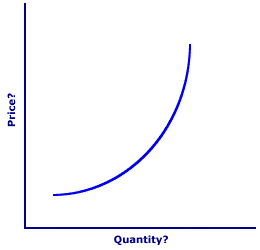
|
|
FACTOR MARKETS: Markets used to exchange the services of a factor of production: labor, capital, land , and entrepreneurship. Factor markets, also termed resource markets, exchange the services of factors, NOT the factors themselves. For example, the labor services of workers are exchanged through factor markets NOT the actual workers. Buying and selling the actual workers is not only slavery (which is illegal) it's also the type of exchange that would take place through product markets, not factor markets. More realistically, capital and land are two resources than can be and are legally exchanged through product markets. The services of these resources, however, are exchanged through factor markets. The value of the services exchanged through factor markets each year is measured as national income.
Visit the GLOSS*arama
|
|


|

|
                           SHORT-RUN AGGREGATE SUPPLY AND MARKET SUPPLY: The short-run aggregate supply curve, or SRAS curve, has similarities to, but differences from, the standard market supply curve. Both are positively sloped. Both relate price and quantity. However, the market supply curve is positively sloped due to the law of diminishing marginal returns and the short-run aggregate supply curve is positively-sloped due to inflexible prices, the pool of natural unemployment, and imbalances in real resource prices. | Two Similar Curves |  |
To illustrate the specific short-run aggregate supply and market supply curve similarities and differences consider the graph of a positively sloped curve displayed here. Is this a market supply curve or an short-run aggregate supply curve? A cursory analysis suggests that it could be either.To reveal the similarities between the both curves, click the [Market Supply] and [Aggregate Supply] buttons. Doing so illustrates that both curves are positively sloped, with each virtually overlaying the other. Consider the differences between these two curves. - First, note that for the market supply curve, the vertical axis measures supply price and the horizontal axis measures quantity supplied. For the short-run aggregate supply curve, however, the vertical axis measures the price level (GDP price deflator) and the horizontal axis measures real production (real GDP).
- Second, the positive slope of the market curve reflects the law of supply and is attributable to the law of diminishing marginal returns. In contrast, the positive slope of the short-run aggregate supply curve is attributable to: (1) inflexible resource prices that often makes it easier to reduce aggregate real production and resource employment when the price level falls, (2) the pool of natural unemployment, consisting of frictional and structural unemployment, that can be used temporarily to increase aggregate real production when the price level rises, and (3) imbalances in the purchasing power of resource prices that can temporarily entice resource owners to produce more or less aggregate real production than they would at full employment. Similar, but different.
Most notable, the differences between market supply and short-run aggregate supply means that it is not possible to merely add up, or aggregate, the market supply curves for the thousands of goods produced in the economy to derive the short-run aggregate supply curve. The short-run aggregate supply curve dances to its own music and plays be its own set of rules.

Recommended Citation:SHORT-RUN AGGREGATE SUPPLY AND MARKET SUPPLY, AmosWEB Encyclonomic WEB*pedia, http://www.AmosWEB.com, AmosWEB LLC, 2000-2025. [Accessed: July 18, 2025].
Check Out These Related Terms... | | | | | |
Or For A Little Background... | | | | | | | | | | |
And For Further Study... | | | | | | | | | | |
Search Again?
Back to the WEB*pedia
|



|

|
GRAY SKITTERY
[What's This?]
Today, you are likely to spend a great deal of time driving to a factory outlet wanting to buy either a coffee cup commemorating yesterday or a replacement remote control for your television. Be on the lookout for a thesaurus filled with typos.
Your Complete Scope
This isn't me! What am I?
|

|
|
In the Middle Ages, pepper was used for bartering, and it was often more valuable and stable in value than gold.
|

|
|
"A winner is someone who recognizes his God-given talents, works his tail off to develop them into skills, and uses those skills to accomplish his goals. " -- Larry Bird, basketball player
|

|
CACM
Central American Common Market
|

|
|
Tell us what you think about AmosWEB. Like what you see? Have suggestions for improvements? Let us know. Click the User Feedback link.
User Feedback
|


|


